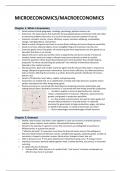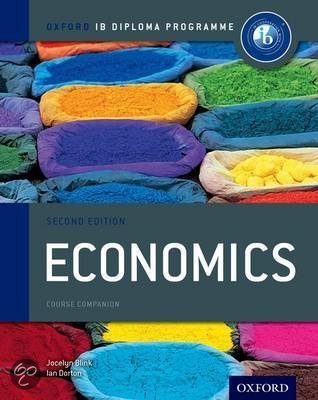MICROECONOMICS/MACROECONOMICS
Chapter 1: What is Economics
o Social sciences include geography, sociology, psychology, political sciences, etc.
o Economics- the social science that examines the way people behave and interact with each other
to overcome problems that arrive as a result of the basic economic problem of scarcity
o Economic concepts: scarcity, choice, efficiency, equity, economic wellbeing, sustainability,
change, interdependence, intervention
o Needs vs wants: things we must have to survive (food, clothing, etc) versus things we would like
o Goods vs services: physical objects versus intangible things (car insurance, haircuts, etc)
o Economic goods versus free goods: all economic goods have opportunity cost; free goods are so
abundant that there is no scarcity
o Opportunity cost is what you sacrifice, there is opportunity cost due to scarcity of resources
needed, choices need to be made to allocate resources and decide on what to sacrifice
o Economic questions: What should be produced and in what quantity? How should things be
produced? For whom should things be produced? Two methods of theoretical allocation:
planned vs free market economy
o Microeconomics deals with smaller economic agents and the choices they make in response to
change. (Respond to government intervention, how to chieve efficiency, etc) Macroeconomics
looks at factors affecting the economy as a whole. (Economic growth, distribution of income,
policies, etc)
o Factors of Production: land, labour, capital, entrepreneurship
o Economists use models that are a simplification of reality and make decisions using the ceteris
paribus assumption (all other things being equal)
o Positive economics is concerned with describing and analysing economic relationships and
making factual claims. Normative economics is concerned with how things should be (subjective)
o be able to explain in terms of opportunity cost, scarcity,
choice, unemployment of resources, efficiency, actual economic
growth, and growth in production possibility
o In a free-market economy prices are used to ration goods and
services while production is in private hands. In a planned
economy the government arranges production, wages, and prices
on behalf of the people. In reality all economies are mixed
o Discuss advantages and disadvantages of both decisions
Chapter 3: Demand
o Market: where buyers and sellers come together to carry out economic transition (product
markets, factor markets, stock markets, international finance markets)
o Demand: the quantity of a good or service that consumers are willing/able to purchase at
different prices at a given time period
(“effective demand” → consumers must have the financial means not just the willingness)
o Non-price determinants of demand: income, complementary goods, substitute goods, number of
consumers, change in consumer income, future prices, changes in taxes, law, etc.
o Shift in demand curve → non-price determinant / Movement along curve → change in price
o Individual consumers demand added together make a market demand, this process in horizontal
summing
o To explain the law of demand:
1. Income effect- when the price of a product falls, “real income” increases, and people can
afford to buy more of a product
, 2. Substitution effect- The price falls, utility remains the same= higher ratio, product is more
attractive
o Rational consumer choice- law of demand assumes we are the homo economicus and make
decisions based on perfect information and rationale
o Behavioural economics- based on decisions of humans and not econs, the study of psychological
decision making to understand consumer choices and create more accurate models
o Cognitive biases- availability bias (recent info), anchoring bias (using reference point), framing
bias (how its presented), social conformity/herd behaviour (to fit in) , status quo/inertia bias
(remains the same), loss aversion bias (feel loss more significantly), hyperbolic discounting (short
term reward over long term)
o Choice architecture→we make choices based on how they are presented to us
Eg. Default choice (google search engine) or mandated choice (organ donation)
o Nudge Theory (Richard Thaler) → consumers maintain consumer sovereignty but are encouraged
to make better choices
Chapter 4: Elasticity of Demand
o Elasticity- measure of responsiveness, used to measure how much something changes when
there is a change in one of the determinants. Used to identify the proportional change of one
variable due to the proportional change of the other
The sign of elasticity shows the correlation between the variables
The size of the answer shows how sensitive the numerator is to the change in the
denominator
o Elasticity of demand- measure of how much demand for a product changes when there is a
change in one of the factors that determine demand. There are two elasticities of demand, PED
(price elasticity of demand) and YED (income elasticity of demand)
% ΔQD ΔQ 𝑃 𝑖𝑛𝑖𝑡𝑖𝑎𝑙 𝑃 𝑖𝑛𝑖𝑡𝑖𝑎𝑙
o PED= = ∗ = 𝑠𝑙𝑜𝑝𝑒 ∗
%ΔP ΔP 𝑄 𝑖𝑛𝑖𝑡𝑖𝑎𝑙 𝑄 𝑖𝑛𝑖𝑡𝑖𝑎𝑙
(𝑄 𝑓𝑖𝑛𝑎𝑙−𝑄 𝑖𝑛𝑖𝑡𝑖𝑎𝑙 𝑃 𝑖𝑛𝑖𝑡𝑖𝑎𝑙
o Eg. ∗
(𝑃 𝑓𝑖𝑛𝑎𝑙−𝑃 𝑖𝑛𝑖𝑡𝑖𝑎𝑙 𝑄 𝑖𝑛𝑖𝑡𝑖𝑎𝑙
o Values→ PED=0, perfectly inelastic / PED=1, Unitary elasticity / PED= infinite, perfectly elastic
Less than one, inelastic / greater than one, elastic
o Price elastic → PED has a lot of effect on total revenue
Price inelastic → PED has little effect on total revenue
o
o Determinants of the size of PED: time, number/closeness substitutes, degree of necessity,
proportion of income spent, how di9fferentiated the product is, relationship firm consumer, who
is paying, preferences, taste, breadth of product
o Importance PED→ provides a precise calculation of the effect of a change in price on quantity
demanded
1. Firms- gathering data on how consumers respond to changes in price can help reduce risk
and uncertainty. Knowledge of the PED can help the firm forecast its sales and set its price.
2. Government- determines tax incidence of a product, the impact of taxes depend on the PED.
When demand is inelastic governments will see significant increase in their tax revenue but
will also cause only a small fall in demand
o Generally primary commodities are more inelastic (low PED values) whilst manufactured goods
are more elastic (higher PED values)
, Determinants Wheat Laptop
Availability of close Relatively few substitutes - Reasonable number of substitutes
substitutes effectively a necessity depending on precise task (e.g.
games consoles etc.)
Luxury or necessity? Necessity Luxury
Proportion of income Depends on nature of economy, Depends on nature of economy,
spent but generally relatively low but generally relatively high - a
one-off purchase
Addictive N/A N/A (Unless you are a gamer?)
Time period Used over a short period - Used continously over a long
consumed immediately period
Number of uses Single use - food Multiple uses - writing, searching,
gaming...
o YED= income elasticity of demand
Tells us how sensitive demand is to the buyers change in income
For a given price, there is a shift of the demand curve, due to the change in income
% ΔQD ΔQD 𝐼𝑛𝑖𝑡𝑖𝑎𝑙 𝑌
o YED= = ∗
%ΔY ΔP 𝐼𝑛𝑖𝑡𝑖𝑎𝑙 𝑄𝐷
o Values
Sign: Size:
o YED>0 = normal goods The more away from the critical value, the
o 0<YED<1 = necessities stronger the responsiveness of the consumer
o YED>1 = luxury good
o YED<0 = inferior good
o Importance of YED →
1. Firms- Useful in forecasting the demand for a product over a period of time. Helps in
estimating the required production level of different commodities at a certain point of time
in the future. Useful in economic planning. Determines whether a good is normal or inferior.
Useful in marketing strategy. Shows fluctuations in demand as precipitated by changes in
purchasing power of consumers. In planning of which markets to enter.
2. Explaining sectoral changes in the structure of the economy- (primary sector, manufacturing
sector and tertiary sector). With increase in incomes the primary sector doesn’t grow as fast
as the manufacturing and service sector do. As incomes increase and living standards in a
country increase, expenditure in the second and third sector increase largely.
Chapter 5: Supply
o Supply- the quantity of a good or service that p[producers are willing and able to supply at
different prices in a given time period
o Law of Supply- “as the price of a product rises, the quantity supplied of the product will increase”
o
o Non-price determinants of supply → costs factors of production, price of related goods,
government intervention, expectation future prices, changes in technology, weather, number of
suppliers
, o Shift of supply curve→ change in non-price determinants
Movement along supply curve → change in price
o Individual producers supply added together make a market supply, this process in horizontal
summing
o To explain the law of supply:
1. The law of diminishing returns- by adding more and more units of a variable factor to its
fixed factor it is logical to assume that the output from each unit added will eventually fall
2. Increasing marginal costs- if the amount produced by each worker decreases the more
workers you get, yet salary remains the same, then marginal cost begins to increase.
*Firms will only increase production and supply more if the price they receive goes up as
output increases, this way marginal costs can be covered.
3. The short run- the period of time in which at least one factor of production is fixed
Chapter 7: Market equilibrium, the price mechanism and market efficiency
o Equilibrium price- The price at which the quantity of a good demanded in a given time period
equals the quantity supplied (determined by a market not an individual economic agent)
o Once achieved the equilibrium doesn’t change unless the demand or supply curve shift, then
there is a new equilibrium to be achieved
o Excess demand occurs when the price of a good is lower than the equilibrium, meaning more
consumers will want to buy the good than suppliers are willing to sell. Excess supply occurs when
the supply price of the good is higher than the equilibrium, meaning the supply is higher than the
amount of the good consumers are willing to buy.
o Price mechanism- the system where forces of demand and supply determine the prices of
commodities and the changes therein
Function- determines what consumers spend their money on and therefore also how scarce
resources are allocated. Prices have three functions, rationing, signalling and incentive
o Consumer surplus- measures the difference between what a consumer is willing/able to pay and
what they actually pay
o Producer surplus- measures the difference between the price producers are willing to sell and
the price they actually sell
o Social/community surplus- the total benefit or welfare to society of an economic transaction
Consumer surplus + producer surplus = community surplus (total benefit to society)
At a free-market equilibrium price, the level of producer and consumer surplus is maximized
Allocative efficiency- at equilibrium community surplus is maximized (allocative efficiency/ pareto) → no
other combination gives a higher/better community surplus, resources are allocated in the most
economically efficient manner (IN THE ABSENCE OF A CHANGE
CH 9 - Market Failure
Economics Study Guide
There are several things that prevent markets from allocating resources in an optimal manner. So,
community surplus is not maximized, and we say this is market failure.
→ governments are expected to intervene and correct that failure
Why the existence of externalities is a market failure
Externality: occurs when the production or consumption of a good or service has effect on a third party.
Negative – external cost that must be added to private costs of the producer or consumer to
reflect the full cost to society.
Positive – an external benefit has been added to the private benefits of the producer of
consumer.





